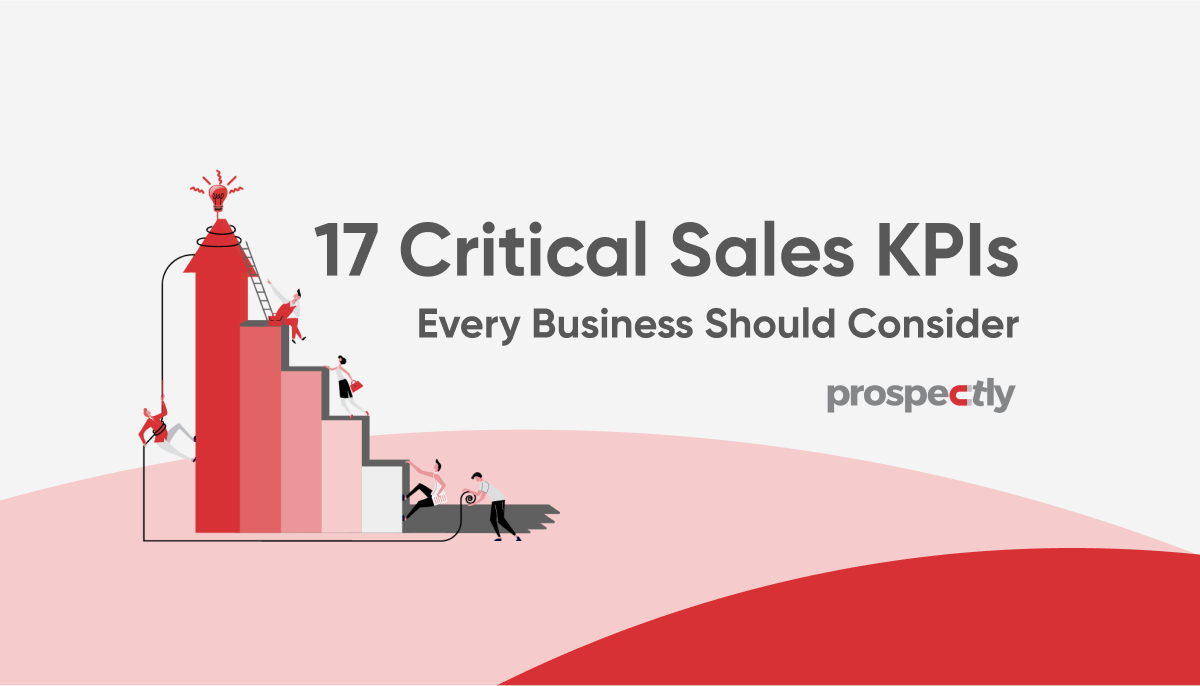Why ignoring key sales metrics will cost you time and sales

Salesperson: “This computer will cut your workload by 50%.”
Office Manager: “That’s great! I’ll take two of them-b2bsalesconnections.com.”
Numbers can be fun and handy to show how reps, teams, and organizations perform against sales targets. That’s why this blog dives into crucial sales metrics that you need to track to gain insights into each stage of the sales process. Sales data points should guide all your sales decisions and where you need to spend time and resources to boost revenue.
You have four ways to improve your sales performance: develop a sales process, hold regular sales meetings, use a CRM tool, and sales stats. Let’s jump into the sales metrics definition to help you understand the whole idea.
What are sales metrics?
Sales metrics are a set of statistics that represent an individual, team, or company’s sales performance. Sales performance metrics can help your business assess progress vs. goals, identify gaps, design training programs to fix them, etc.
What is sales analytics?
“Sales data analytics is the review of sales data, metrics, and trends to gain insights that can improve sales team performance, sales productivity, and sales effectiveness, help drive accurate sales forecasts, and refine the overall sales process-Clari.com.”
Sales data analytics is crucial for your organization because you can use the info to improve revenue.

Some people use sales metrics and sales KPIs interchangeably. But are they similar in meaning?
Sales metrics vs. KPIs
Sales metrics are data points to measure the sales results of an individual, team, or company’s activities over a specific time.
Sales KPIs (Key Performance Indicators) are metrics connected with the overall strategic company goal. For example, sales growth is a sales KPI. But raising revenue by 25% every year is a sales metric to achieve the long-term objective.
What are metrics used for?
Sales metrics have several benefits for your business. Here are examples.
Improve rep’s performance
By analyzing your sales data, you can see where your seller or team lacks. Sales stats also reveal your salesforce’s strengths. As a result, sales managers can correct wrong selling behaviors or adjust strategies to address the gaps.
Sales representatives also become accountable for their outcomes. Sales leaders can rely on the info to create data-driven sales coaching instead of using their opinions.

Offer more insights about the sales process
Sales analytics help you understand the state of your sales team. You gain insights into your team’s sales trends, the movers, and shakers. Do deals close slower than last year? Have contract values fallen? How can you get the team back on track?
Examples of sales metrics
How do you measure sales performance? Sales metrics can help your company evaluate progress. And there are many examples of sales data points you can use. But which ones should your business choose? Pick sales metrics that matter for your salespeople.
Zippia.com quotes a study by Jason Jordan, Vantage Point Performance, and Sales Education Foundation. The research found that sales leaders considered over 306 metrics as necessary.
The study grouped the sales data into metrics relating to business results, sales objectives, and sales activities.
Business result metrics represent the overall performance of your entire organization-think of total revenue. However, the researchers say sales experts can’t directly influence the company revenue.
Sales objective metrics have to do with the specific targets you give your sales team-think of sales quotas. Again, the study insists that sellers have no direct control over these goals. That’s because customers should agree to buy products for reps to hit their quota.
Sales activity metrics show the seller’s daily tasks. Also, managers can control this data-it’s easy to influence the metrics. Below are some examples of sales activity metrics.
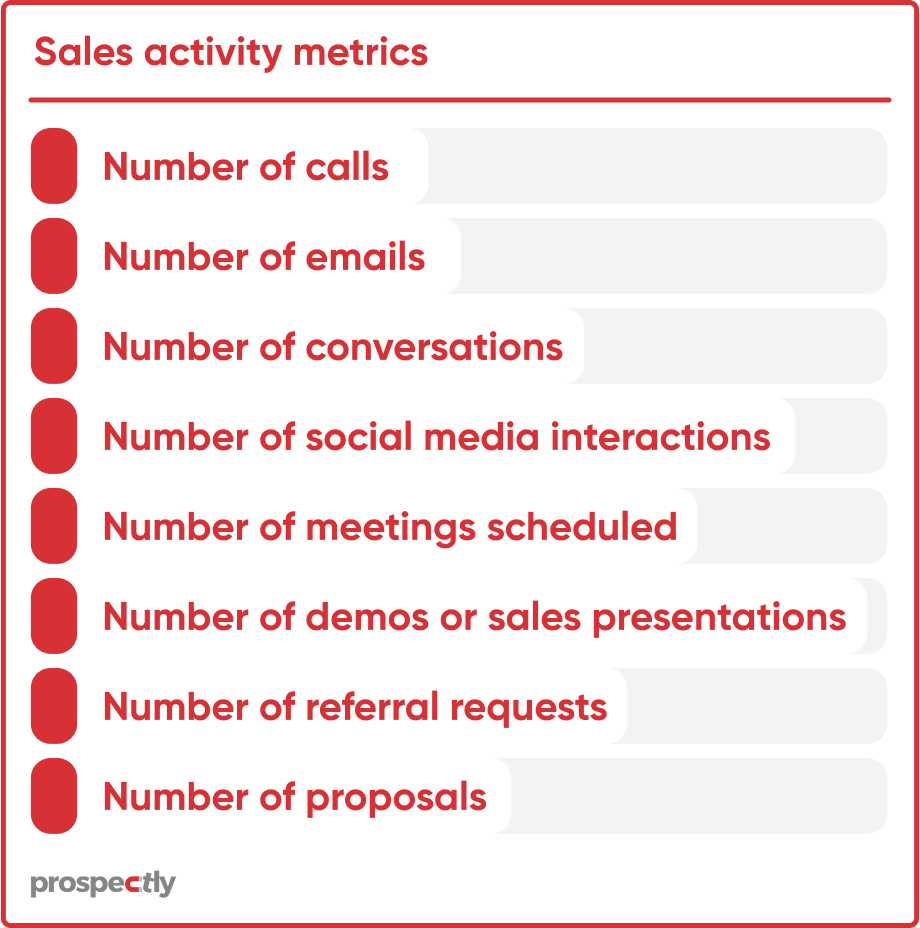
Your company should zero in on what your sellers and managers can influence. Activity metrics are more crucial than all the other data. The researchers discovered that even though these businesses don’t measure their sales activity metrics, they can control them.
According to the findings, companies focused on 17% of activity metrics, 24% of business results, and 59% of business objectives. It means that sales leaders spent a lot of time managing 83 % of uncontrollable sales metrics.
What does it mean for you? It’s a waste of your time, effort, and resources to concentrate on sales data you can’t change.
There are crucial activities leaders need to emphasize to drive sales objectives and business results. Jason Jordan on Zippia.com identifies prospecting and sales coaching as top tasks for managers.
A sales manager should spend most of their time on prospecting to raise a salesperson’s performance. You would do well to focus on activity metrics and coaching reps. It’ll lead to skyrocketing business results.
John Cheney is the CEO & Founder of Workbooks CRM. He identifies three stats that a sales organization should consider. Examples include the number of leads, the rep’s performance (the conversion rate), and the mix of the deals.
The combination of deals refers to the source of your opportunities for your pipeline. They should come from three places-the accounting management team, the marketing department, and partners.
You need to know how you receive leads. It’ll show you whether you should put more effort into your customer base, business partners, or accounting. Also, you can increase your sales cadence and sales revenue growth by narrowing your focus on what you can influence.
Sales productivity metrics are related to sales activities. They measure the rate at which your sellers reach their revenue goals. High productivity means that your salespeople take less time to achieve their quota. Here are some examples.
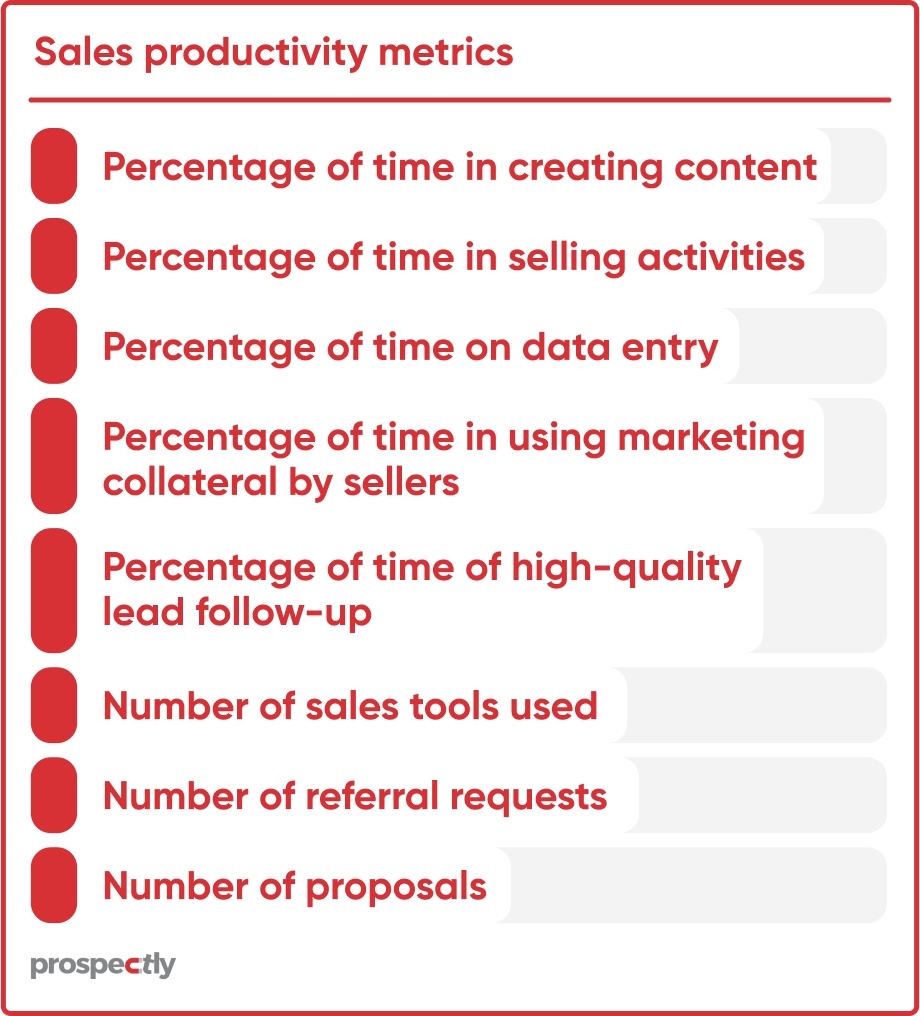
Lead generation metrics – Prospecting is a sales cycle activity that Vantage Point Performance and others identified as essential in their study. Weak prospecting leads to an empty sales pipeline and a drop in revenue. Use the following lead generation numbers to see how well your sellers prospect.
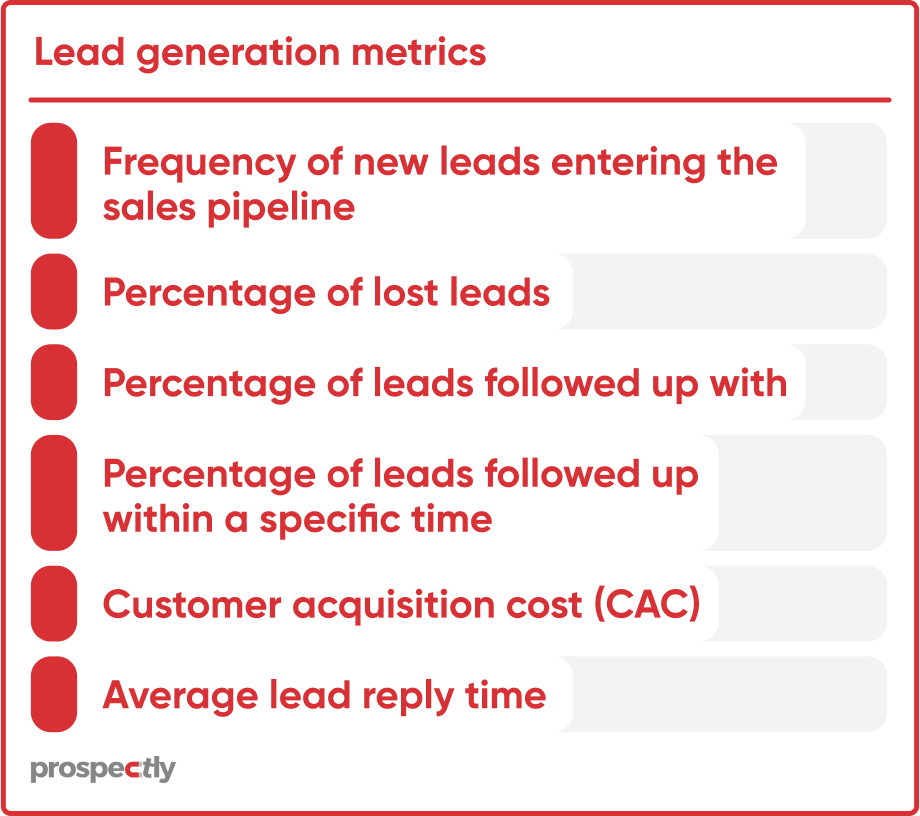
What are the 5 most important metrics for SaaS companies?
SaaS companies have five key metrics they need to monitor, as well. Some examples include:
1. Annual recurring revenue (ARR)
ARR is an indicator of the revenue you receive from subscribers who have a 12-month agreement with your business. It’s a helpful metric because it shows sales efforts you should repeat or improve to boost revenue.
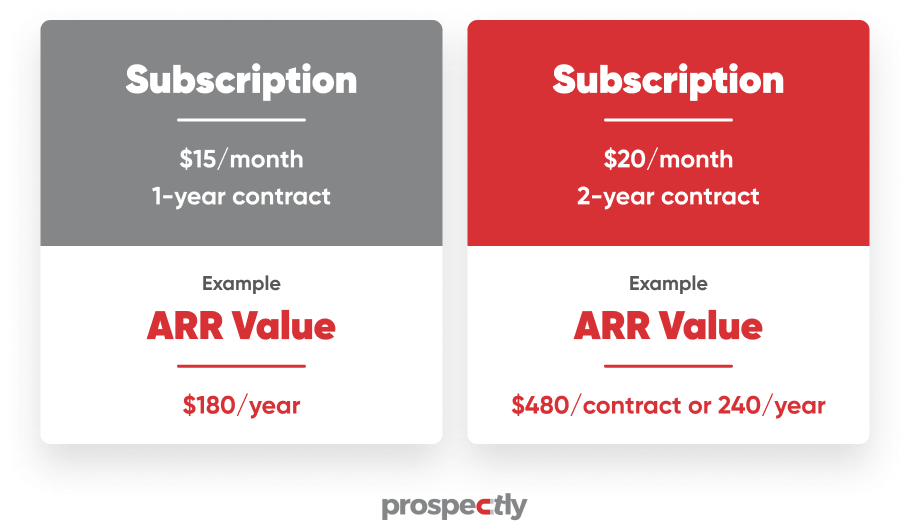
2. Monthly recurring revenue (MRR)
MRR calculates the expected revenue from your customers. There are two ways of measuring it.
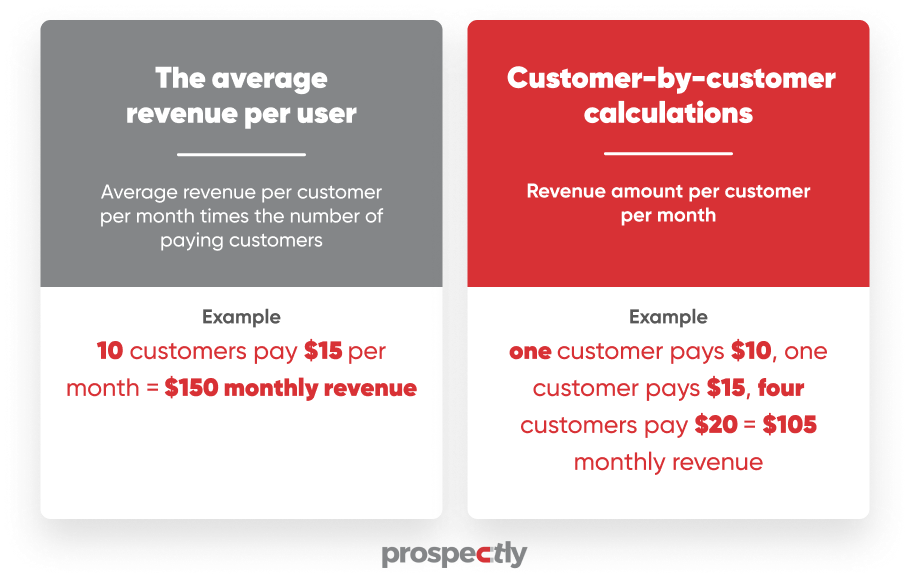
You can use a sales dashboard to calculate the metrics.
3. Churn rates
It measures the loss in contracts, bookings, customers, MRR, contract value, etc. Here are some examples of how to calculate churn rates.
Customer churn rate (also called customer defection/customer turnover/customer attrition) is the loss of customers.
Formula

An increase in your churn rate means that you need to evaluate your product or service.
Revenue churn is the loss of income over a period, and you can calculate it using the customer churn formula. However, you need to pick a starting point and remove all the income you earned during that time.
E.g., 2021 third quarter revenue $50,000
2021 fourth quarter revenue $ 35,000
Revenue churn is 30% ($50,000-$35,000)/50,000
Recurring revenue (ARR//MRR) is ideal if you’re offering different products or services. It measures the loss of income from clients who canceled or downgraded over a period.
E.g., Company had 20 customers paying $100 each in March and 15 paying the same amount in April.
Revenue churn is 20 x $100 (March)= 200
15 x $100 (April)= $150
$200-$150=$50/$200
Churn is 25%
4. Customer Life Value (CLV)
The SaaS metric gives you the total revenue after subtracting expenses per customer. How much income will you obtain from a subscriber minus the costs of acquiring them? Typically, the customer acquisition costs should be less than the revenue you’ll receive from them.
5. Renewal rate/customer renewal rate/customer retention rate
It’s the number of customers that continue their relationship with your business (such as subscriptions and memberships). It tells you about your ability to grow long-term relationships with your buyers.
There are two ways of measuring the renewal rate.
The Customer approach considers the number of customers who renewed their contracts vs. those who must renew their agreements.
Formula:

The Revenue method measures the customer renewal rate by dividing the actual income by the potential income to be earned from clients.
Formula:

How to measure sales metrics
We stressed that sales managers should spend a lot of energy on activity metrics to achieve sales objectives and business results.
Conversion rate
Conversion rate is a crucial sales metric because you can calculate the percentage of potential customers that have become buyers. It reveals the type of leads and performance of individual sellers, teams, and marketing. From this, you can determine whether your lead generation activities are practical.
Formula

Tracking the conversion rate helps you align the marketing and sales teams to improve lead quality. Reps can focus on the right customers for your business.
Win rate
Win rate measures the percentage of quoted deals that your sales reps have converted into sales. Is your sales force effective in turning proposals into sales? The metric allows you to assess each salesperson’s progress.
You can also determine future sales leads by calculating the win rate metric to reach your targets.
Formula

Sales metric tools
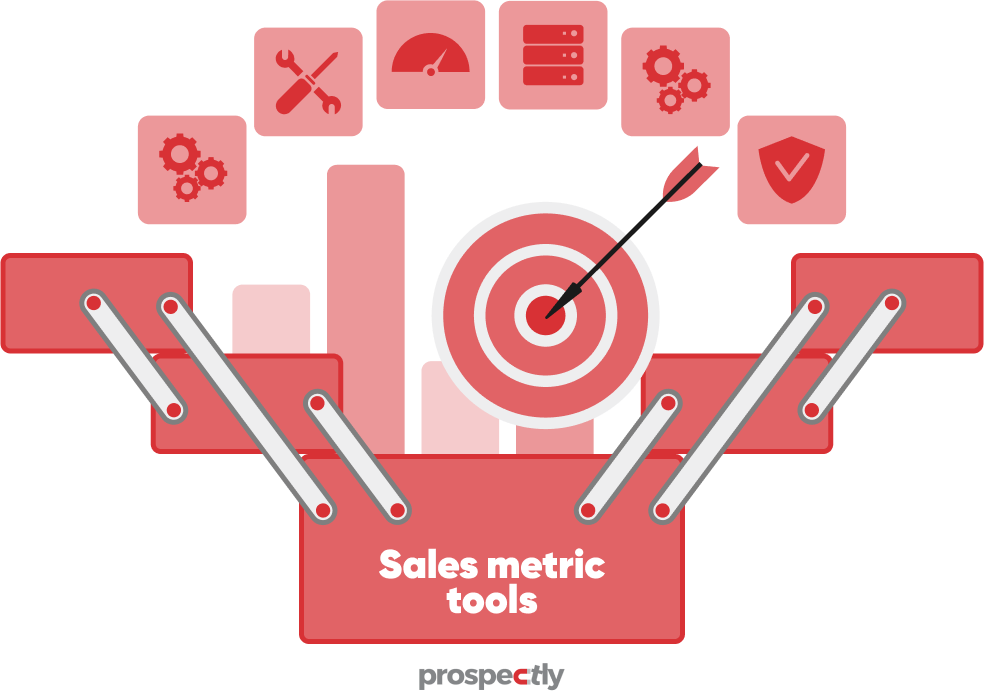
The right tools can help you collect, organize, analyze, and share data with relevant stakeholders. Check out the following platforms you can use to visualize and understand sales data.
CRM system
A customer relationship management platform organizes all your business data and activities as you engage with your customers.
Automation tools
Automation apps are marketing tools that offer you insights into the sales pipeline leads. You can monitor the sales opportunities as they move through the pipeline. As a result, you can evaluate sales activities and performance.
Data dashboard
A sales dashboard brings all the critical sales metrics together on one platform. It collects data from separate sources and provides you with the latest updates. You can visualize, analyze, and distribute the data as reports.
Examples of sales metrics you can measure and track using a data dashboard include:
Win rate: The percentage of deals you won or lost.
Demo-to-close ratio: It’s the number of presented demos divided by the number of won deals.
Average deal size: Its total sales divided by the number of closed deals (monthly or yearly).
Churn rate: It measures the percentage of buyers who discontinue contracts or cancel subscriptions. Chun rate tells you whether you can retain customers.
Revenue by product: How much each product has generated revenue.
Customer retention rate: It’s the number of loyal customers.
Customer acquisition costs (CAC): It’s what you have spent on marketing and sales activities vs. the revenue from acquired customers.
Reports
Reports summarize the performance of each salesperson and marketing department. They should show you information about what sellers have achieved, their success, and their training needs.
Sales report templates can help your reps track their progress and be accountable for their activities.
Final Thoughts
What are the best sales KPIs? The key sales metrics to track are those that your business can influence. According to the research we discussed, sales leaders monitor too many numbers. Because of this, they waste time and resources on uncontrollable sales data points.
Instead, you should chase activity metrics because they show each rep’s performance, strengths, and weaknesses. You can directly manage them. Once you understand this data, you can design sales coaching and training programs to address the weakest links.
Business results and objectives will increase when your sales force improves at every sales process stage. Your company can achieve its total revenue targets. Focus on what your salespeople can control and use a sales dashboard to monitor your primary metrics.
